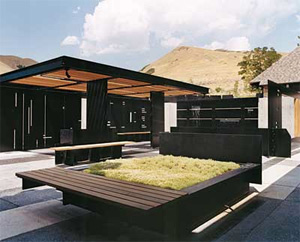How the network works
Networking, of course, helps if you practice architecture near your alma mater, and can make use of all those former colleagues who later turn into potential clients. Some women don’t do this. Helfand grew up in California, went east to Swarthmore College, in Pennsylvania, but then headed back west to study architecture at the University of California, Berkeley, before settling in New York, where she started her own office 25 years ago. Jennifer Luce grew up in Canada, and then worked in Virginia before moving to San Diego in 1987, where she could not rely on academic or professional contacts. “It took a long time,” she says.

![]() Female Firms, Male Values? Are women trying too much to emulate men's values, attitudes and approaches in order to run successful architecture firms? Respond now.
Female Firms, Male Values? Are women trying too much to emulate men's values, attitudes and approaches in order to run successful architecture firms? Respond now.
Similarly, McKinney studied architecture at the University of Pennsylvania, in Philadelphia, and then worked in Boston before heading for Austin in 1984, where most of the architects went to the University of Texas. She too had to build up contacts over the years, but cites her involvement with the organization Austin Women in Architecture as crucial in fostering communication among colleagues.
A number of women find meeting architects through architectural organizations leads to jobs. Wendy Evans Joseph, who has served as president of the New York Architectural League, and, like Helfand, was a president of the New York chapter of the AIA, reports that the commission to design The Inn at Price Tower in Frank Lloyd Wright’s landmark structure in Bartlesville, Oklahoma, came through architects in Tulsa whom she met on an AIA committee. “It was too small a job for them and required a fair amount of interior design,” she says. Leers notes that teaching, besides providing a way of exploring ideas, turns out to be good for networking. “Male teaching colleagues have turned out to be advocates and sponsors of our firm, particularly in situations where they are advising clients, boards of directors, and deans of schools on upcoming buildings,” she says.
Marked women
In terms of marketing and getting the job, the women are quite aware they are still unusual. Leers accepts that “women are marked,” and need to be conscious of that while walking into an interview: “Jane and I see a design challenge; the client sees two women.” In going into the client meeting, many women note that the presentation style, including the dress, sends important subliminal signals. Helfand decided early on that “I might as well be a billboard for my architecture.” Clients and press have commented (approvingly) that the geometric, simple lines, varied textures, and crafted details of her attire provide a fitting correlative to her Modernist design work.
A number of women notice that clients comment on their working style, as well. According to Cowley, clients remark that women listen to them, an observation that a number of other females corroborate. As Luce puts it, “Clients feel we don’t have an ego thing.” It also makes the job in the office go more smoothly. Sorg says, “I love working with women; they aren’t defensive about their mistakes.” In the old days, however, there was too little ego demanded of women. At 79, Debora K. Reiser, who graduated from Pratt in 1948, but never got her license, has been in a variety of work situations, ranging from working with George Nemeny, in New York, to having her own firm, in Dobbs Ferry, New York, and forming an association with her son, Jesse Reiser, and his partner Naneko Umemoto, based in New York. As she recalls, “When I started, women hid in the back of the room. If the clients thought a woman worked on the project, they wouldn’t respect the design.”
On-site
Today, when women go out to the construction sites, they often meet up with contractors long stereotyped as having an adversarial role with architects. Cowley observes that contractors seem to fall into three groups: “One third of them don’t want to be told what to do; one third want to be told, but constantly have to let you know they know what they’re doing; and one third, no matter what, want to pick a fight.” Nevertheless, a number of the women say that after they show they know what they are talking about, the job runs smoothly. Yet Karahan remarks that when she visits a site for publicly sponsored work, the contractor’s questions are rarely directed to her—always to the project architect, often a man. (Karahan, who teaches design studio and building construction at the New York Institute of Technology [NYIT], obviously knows the answers.) Dubbeldam comments that she usually doesn’t have this problem—“but it helps that I am 6 feet tall,” she says, half-jokingly. Osler also comments that her 6-foot-tall height often catches the men on the construction site off guard. One medium-height woman quipped that at least they can wear high-heeled boots if they need some extra “stature.” Most female architects say that as they get older, the gender perceptions disappear, although Berry thinks she got her way more often with contractors when she was first starting out in her thirties. “They treat you differently when you’re young. You can play with them. Youth can be tremendously persuasive.” Yet Lewis conjectures contractors trust women more than men, noting, “They know women are going to be straight as an arrow about the payment schedule.”



Post a comment to this article
Report Abusive Comment